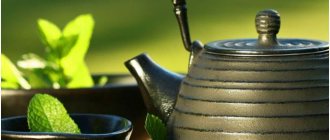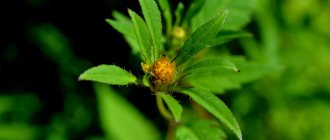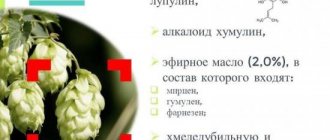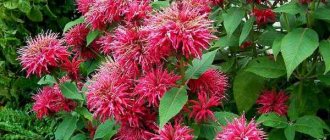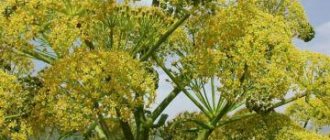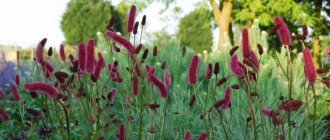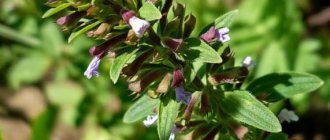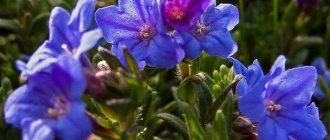A little history
The medicinal plant mint has a truly divine origin. It received its name in honor of the character of the ancient Greek myth, with whom a sad story is connected.
The goddess of Mount Mente became the concubine of Hades, the ruler of the kingdom of the dead, married to Parsephone. The love triangle, as usual, did not bring anything good. After all the ordeals, the girl was literally trampled either by her legal spouse, or by her mother - Demeter herself. The nymph turned into a tender plant with fragrant green leaves.
Mint was widely used by Arab, Chinese, and Japanese healers. Ancient healers and medieval scientists knew its medicinal properties very well. The ancient Romans noticed that the smell of mint lifts the mood and stimulates the thought process.
Today mint is grown everywhere. She is unpretentious and feels great in the garden and on the balcony. In my dacha it grows like a weed, but I can’t get up to weeding it out. Let's take a closer look at what's so useful about it.
Chemical composition
The leaves contain B vitamins, carotene, vitamins D, E and PP. They are rich in calcium, phosphorus, manganese, iron, magnesium and copper. They contain other substances necessary for humans:
- glycine, arginine, other amino acids;
- betaine;
- glucose;
- phytosterol;
- organic acids;
- tannins,
- flavonoids,
- other biologically active components.
Peppermint essential oil is the main value of green shoots. It contains more than 40 unique chemical compounds. The main active ingredient is menthol. The substance is used in the perfumery and food industries, for the production of cosmetics and pharmaceuticals.
Compound
This aroma is a consequence of the content of a whole set of essential oils and menthol that mint has. The medicinal properties and contraindications can be understood by studying the composition of the plant, which includes a large number of useful vitamins, substances and microelements, namely:
- vitamins - C, B1, PP, A, B5, B9, B2, B6;
- microelements - phosphorus, manganese, iron, copper, magnesium, zinc, sodium, potassium;
- amino acids such as betaine and arginine;
- fatty acid;
- organic acids, including chlorogenic, ursulic, oleonolic, ascorbic, acetic, caffeic and valeric;
- piperitonin pinene;
- essential oils;
- menthofuran;
- from flavodinodes - hesperidin;
- from tannins - rutin;
- phytosterols and phytosterols;
- saponins;
- alimentary fiber;
- resins;
- alcohols;
- Terpenes: citral, geraniol, limonene, terpinene, carvacrol.
It consists of seventy-eight percent water and two and a half percent essential oils.
Dietary fiber per hundred grams of leaves contains:
- fat - 1 g;
- carbohydrates - about 7 g;
- proteins - about 4 g.
The energy value for the indicated weight is seventy-one kilocalories. This plant is a storehouse of useful qualities.
Peppermint: beneficial properties and contraindications
Folk remedies can help with most diseases. Mint leaves are included in choleretic and stomach preparations, soothing decoctions, tinctures for headaches and diseases of the upper respiratory tract.
For migraine sufferers, mint (along with ginger) is the number one remedy. It relieves nausea and prevents vomiting.
In folk medicine, the leaves are used externally for the speedy healing of burns and inflammations. Peppermint is a strong antiseptic. It helps with eczema and toothache, and prevents the spread of bacteria and fungus.
Weed has a complex effect on health: from improving brain function to normalizing hormonal levels
Decoctions of the leaves are drunk for coughs and loss of voice. They quickly calm down, relieve pain, cure flatulence and digestive disorders. Mint contains menthol. It relaxes the digestive tract and brings relief from intestinal colic and spasms.
Scientific research indicates the ability of mint to improve cognitive function, especially in the elderly. Some sources recommend a decoction as a mouth rinse. It ensures proper oral hygiene.
Menthol is extracted from essential oil. It is part of such popular drugs as validol, corvalol, valocordin.
What should you pay attention to?
As a food ingredient, peppermint poses no risk to most people. It has few negative sides, but there are some features:
- If you have low blood pressure, be careful not to make the situation worse.
- The product is not recommended for children, pregnant or lactating women.
- Allergy sufferers, monitor your reaction.
In large doses, weed is not recommended for kidney and liver diseases. If you decide to take supplements with it, discuss this with your doctor. There is evidence of poor compatibility with certain sedatives and antihistamines, Tylenol (paracetamol), fluconazole, and some other drugs.
What are the benefits of mint for women?
It is no coincidence that mint is popularly called a woman's herb. It’s not surprising if you remember the history of the name’s origin. It has a beneficial effect on the female body:
- removes swelling,
- normalizes the menstrual cycle,
- protects against hot flashes during menopause,
- fights inflammation of the pelvic organs,
- relieves the condition during critical days,
- relieves PMS symptoms.
Peppermint is drunk for painful menstruation, depression, nervous breakdowns, headaches and muscle pain.
In the old days, when a nursing woman had stagnant milk, a paste of green shoots was applied to her breasts. The procedure helped prevent the development of mastitis. But it is better not to take it orally for a nursing mother, so as not to suppress milk production.
Mint infusions and decoctions have proven themselves in home cosmetology. They are used to make masks and applications. I will talk about them below. Rinsing your hair gets rid of dandruff, strengthens hair follicles, and gives your hair a healthy shine.
Do not forget that mint reduces the level of androgens in the blood. An excess of the male hormone testosterone is accompanied by the growth of unnecessary hair on the face and body, a tendency to seborrhea, and acne. If such a deviation occurs, then follow the doctor’s recommendations and add green leaves more often to various dishes.
The benefits and harms of mint for a woman’s health after 50 are a separate matter. Natural aging of the body is accompanied by various changes affecting the reproductive system. The functioning of the heart and blood vessels is disrupted, and the thyroid gland suffers.
A medicinal herb for menopause can relieve the symptoms of hot flashes, fever, and improve the psycho-emotional background.
Antiandrogens and phytoestrogens in mint are natural analogues of sex hormones, the amount of which decreases at this age. They prevent increased fatigue and have a positive effect on appearance, but their effect on humans has not yet been fully studied.
Contraindications and harm
The benefits and harm to the body from mint depend on the correct use of it. Before using the plant, you need to familiarize yourself with the contraindications:
- the presence of individual intolerance to individual components of the plant, which manifests itself in allergic reactions;
- phlebeurysm;
- weak fertility - mint inhibits the functioning of the female and male reproductive systems, which can lead to the inability to conceive a child;
- increased drowsiness that occurs against the background of certain diseases;
- frequent attacks of heartburn - in this case, mint can be taken, but in small quantities, so as not to increase the intensity of heartburn;
- gastritis with low acidity;
- hypotension;
- Child age - up to 3 years: due to an unformed immune system, mint can lead to allergies.
Men should not overuse the amount of mints, as they have a depressing effect on the male reproductive system and can lead to weakened erections.
People with low acidity of gastric juice and varicose veins using mint products can cause great harm to their health. In these cases, consuming the plant aggravates the course of the disease and makes the symptoms more pronounced.
The benefit of mint for a pregnant woman is that it helps fight the manifestations of toxicosis. The plant eliminates attacks of nausea and heartburn, invigorates and tones, saturates the body with useful substances. But if you take mint decoctions and teas in large quantities, this can lead to an increase in uterine tone.
In the early stages, this is fraught with spontaneous miscarriage, in the later stages - premature labor.
During lactation, abuse of mint can lead to a decrease in the volume of milk produced, up to complete absence. In this regard, the benefits and harms of mint for the body of a pregnant and breastfeeding woman are determined by the doctor, and he decides whether medications from this plant can be taken and in what quantities.
The benefits and effects of mint on men
The effect of mint on men is ambiguous. The herb treats them the same way as women. But the substances contained in the plant are harmful to men. Mint negatively affects potency in men and hormonal levels.
The total dose of the plant is calculated by a specialist, but tea once a week will not cause any harm. For older males, the herb will be useful as a tonic and at the same time a sedative.
The harmful properties of mint herb for men outweigh the beneficial ones, so treatment with it is not recommended.
The benefits and effects of mint on the woman’s body
For women, the medicinal properties of mint herb are greater than the harmful ones. You just need to follow the recommendations. Mint is beneficial for the face, for colds, and diseases of the female reproductive system. It is prescribed for:
- painful menstruation, due to its analgesic properties;
- premenstrual syndrome, migraines and muscle pain;
- nervous breakdowns and depression.
In addition, mint is good for the stomach; its properties are to cure digestive disorders and alleviate poisoning, eliminating vomiting and nausea.
Is mint good for pregnancy?
Medicines containing the plant treat constipation and nausea, but mint is contraindicated for pregnant women, not only in the early stages. The grass will harm the fetus and may cause miscarriage in the early stages. An exception is when, after consultation, the doctor prescribed the exact dose of the plant and method of administration.
Is it possible to take mint while breastfeeding?
Nursing mothers can take mint without consulting a doctor only in the form of aromatherapy. On the recommendation of a specialist, it is useful to take the plant internally in small doses to increase the amount of breast milk. To do this, the herb is mixed with other products: dill seeds or oregano plant.
We advise you to read: Red tea: features, composition, types, beneficial properties
Unnatural imitation fragrance will be harmful to nursing mothers, even if inhaled.
What are the benefits of the medicinal plant mint for children?
The first thing we consider important to warn you about is that mint is contraindicated for children under three years of age. The children's nervous system is still beginning to develop, so such experiments are not recommended. For older children, if they are overexcited, it is permissible to add a mint leaf and a teaspoon of honey to their tea.
For inflammatory processes in the throat, children are offered mint tea with the addition of chamomile infusion. In hot weather, a mint leaf can be added to homemade children's lemonade. This drink will be very refreshing, even if the lemonade is not cold.
If the doctor considers it acceptable, then children even under three years old can be offered a bath with string, mint and chamomile. In this case, the herbs are taken in smaller quantities. We can offer this recipe for a baby mint bath: 3 tbsp. l. Brew dry mint and the same amount of chamomile in 0.5 liters of boiling water. After 40 minutes, the broth can be poured into a warm bath, after which the child will feel relaxed. For problems with the skin, chamomile is replaced in succession.
Peppermint oil can be added to a baby bath in the amount of 1-2 drops only for children over one year old
Mint tea: medicinal properties and contraindications
This pleasant drink is famous for its unforgettable taste and healing qualities. The effect extends to the entire body. It is refreshing in hot weather, helps cope with colds in winter, and relieves migraine attacks. There are other positive aspects too. It is recommended for:
- headaches, insomnia, hypertension, nervous excitement;
- cough, sore throat;
- indigestion, heartburn;
- cramps, constipation, fluid retention.
It has been noted that such a drink calms you down in the evening, and invigorates you in the morning just as much as coffee. It has a mild diuretic effect. In addition, it accelerates recovery from colds, slows down aging, and relieves insomnia.
The drink relaxes and improves your mood. It calms the nervous system without causing addiction or excessive drowsiness. Mint regulates appetite, helps prevent overeating and cravings for sweets.
The effect of herbal teas on children's bodies has been fully studied, so it is not recommended to give the drink to a child under 6 years of age. When introducing a new product, monitor the reaction for allergies or signs of intolerance.
Doctors do not advise men to consume mint on a regular basis. The point is the herb’s ability to reduce the level of male sex hormones. Pregnant or breastfeeding women should not get carried away with it. Their hormonal levels are already disrupted. Hypotonics (people with low blood pressure) are also advised to abstain.
The safe daily intake for a woman’s health is 1-2 cups per day with a mandatory break after a two-week course.
How to brew mint tea?
I got into the habit of throwing a sprig of peppermint into the kettle. The taste is refreshing, and sleep becomes stronger after drinking tea. Proper brewing requires compliance with the following rules:
- Take porcelain or ceramic dishes.
- Let the water boil for a couple of minutes and then cool to 80 oC.
- For each glass of boiling water, put a teaspoon of tea leaves, plus the same amount of dried mint.
- Pour in, cover with a lid, wait 4 minutes, serve.
The healing and taste properties do not last long, so drink immediately, hot or chilled.
Mint-berry drink
Add fresh, dried or frozen raspberries, sea buckthorn or cranberries to the container with the grass. A piece of dogwood or strawberry mashed with sugar is suitable. Blueberries give an interesting shade. If possible, try making a mix with lingonberries and blueberries.
With apples and citruses
As a complement to the mint infusion, add orange zest and a slice of lime. For a half-liter container, take 30 g of raw materials, the juice of half a lemon, 10 grams of sugar and an apple, cut into slices with the peel:
- throw the selected components into the boiling liquid,
- put out the fire
- cover with a lid
- let it brew.
Once in a Kerch cafe I was served mint tea with tangerines. The taste is magical and unforgettable. Unfortunately, the recipe could not be reproduced. No matter how hard I tried, it didn’t work out right. If you know the secret, please share in the comments



